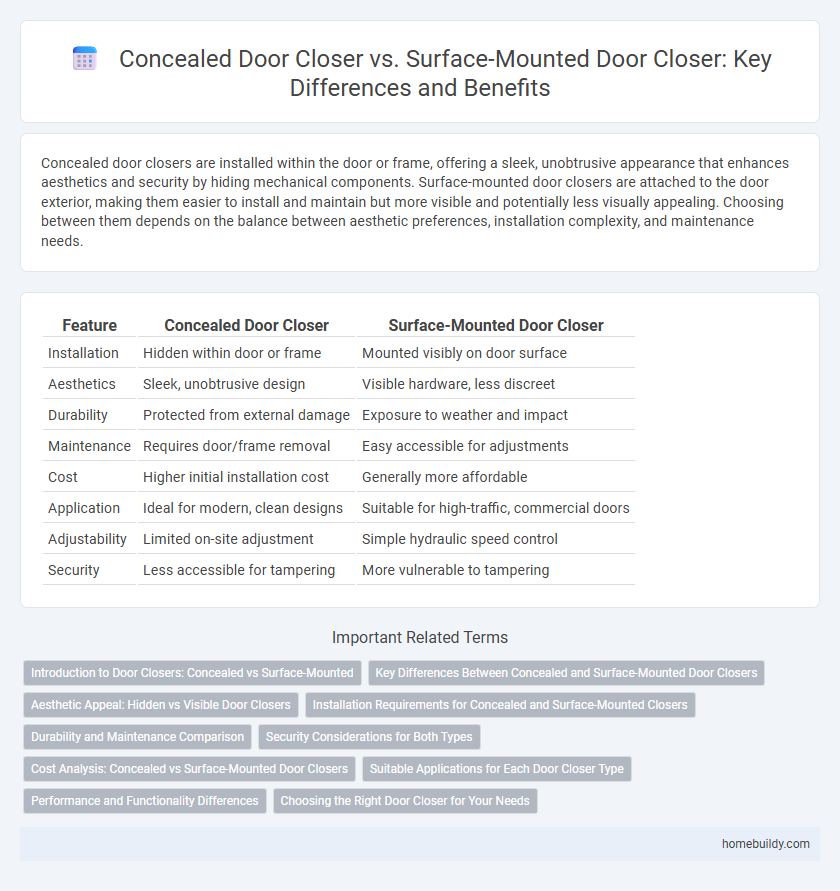Concealed door closers are installed within the door or frame, offering a sleek, unobtrusive appearance that enhances aesthetics and security by hiding mechanical components. Surface-mounted door closers are attached to the door exterior, making them easier to install and maintain but more visible and potentially less visually appealing. Choosing between them depends on the balance between aesthetic preferences, installation complexity, and maintenance needs.
Table of Comparison
| Feature | Concealed Door Closer | Surface-Mounted Door Closer |
|---|---|---|
| Installation | Hidden within door or frame | Mounted visibly on door surface |
| Aesthetics | Sleek, unobtrusive design | Visible hardware, less discreet |
| Durability | Protected from external damage | Exposure to weather and impact |
| Maintenance | Requires door/frame removal | Easy accessible for adjustments |
| Cost | Higher initial installation cost | Generally more affordable |
| Application | Ideal for modern, clean designs | Suitable for high-traffic, commercial doors |
| Adjustability | Limited on-site adjustment | Simple hydraulic speed control |
| Security | Less accessible for tampering | More vulnerable to tampering |
Introduction to Door Closers: Concealed vs Surface-Mounted
Concealed door closers are integrated within the door or frame, offering an aesthetic and tamper-resistant solution ideal for modern interiors. Surface-mounted door closers attach externally to the door surface, providing easier installation and maintenance while accommodating a wide range of door types. Both types regulate door closing speed and ensure security, but choice depends on factors like design preference, door material, and maintenance access.
Key Differences Between Concealed and Surface-Mounted Door Closers
Concealed door closers are installed within the door frame or door leaf, providing a discreet appearance that maintains aesthetic integrity and reduces vandalism risk. Surface-mounted door closers are externally attached to the door and frame, offering easier installation and maintenance but with a more visible profile. Key differences include installation complexity, visibility, durability, and suitability for different door types, with concealed closers preferred for sleek design and security, while surface-mounted options are favored for retrofit projects and heavy-duty use.
Aesthetic Appeal: Hidden vs Visible Door Closers
Concealed door closers offer a sleek, minimalist aesthetic by being hidden within the door frame or door leaf, maintaining clean lines and unobstructed surfaces ideal for modern and high-end interiors. Surface-mounted door closers, while more visible and sometimes bulky, provide easier access for adjustments and maintenance, making them a practical choice for commercial or high-traffic areas. The choice between concealed and surface-mounted door closers significantly impacts the visual harmony of a space, balancing aesthetic appeal with functional considerations.
Installation Requirements for Concealed and Surface-Mounted Closers
Concealed door closers require precise mortising within the door or frame, demanding skilled carpentry and more installation time compared to surface-mounted models. Surface-mounted door closers offer straightforward installation with easily accessible mounting points on the door surface, reducing labor and modification needs. Choosing between these options depends on structural compatibility, aesthetic preference, and available installation resources.
Durability and Maintenance Comparison
Concealed door closers offer enhanced durability due to their protection from external elements, reducing wear and tear compared to surface-mounted models. Maintenance is less frequent for concealed door closers as their hidden components are less exposed to dust, moisture, and vandalism. Conversely, surface-mounted door closers require regular inspection and cleaning to prevent corrosion and mechanical failure, impacting long-term reliability.
Security Considerations for Both Types
Concealed door closers enhance security by being hidden from view, reducing the risk of tampering or vandalism, and providing a clean aesthetic that supports secure entryways. Surface-mounted door closers, while more accessible for maintenance, may be more vulnerable to physical damage or forced entry attempts due to their exposed placement. Both types must comply with fire safety standards and security regulations to ensure effective door operation and authorized access control.
Cost Analysis: Concealed vs Surface-Mounted Door Closers
Concealed door closers generally have higher initial costs due to complex installation and specialized hardware, whereas surface-mounted door closers offer a more budget-friendly option with easier installation. Maintenance expenses for concealed closers tend to be lower over time because of reduced exposure to environmental damage and tampering, contrasting with surface-mounted designs that may require more frequent repairs. Evaluating long-term cost efficiency involves balancing upfront investment against durability and maintenance needs specific to the door's usage environment.
Suitable Applications for Each Door Closer Type
Concealed door closers are ideal for residential and high-end commercial spaces where aesthetics and minimal hardware visibility are paramount, often used in wooden or glass doors. Surface-mounted door closers offer robust durability and ease of installation, making them suitable for heavy traffic areas such as schools, hospitals, and industrial facilities. Both types provide reliable door control but cater to different design requirements and functional demands based on their installation and operational mechanisms.
Performance and Functionality Differences
Concealed door closers offer a sleek aesthetic by being installed within the door or frame, providing enhanced security and protection from vandalism compared to surface-mounted models. Surface-mounted door closers are easier to install and maintain, delivering robust performance for a wide range of door types but may be more susceptible to damage and tampering. Performance differences include smoother, quieter operation and reduced wear with concealed closers, while surface-mounted closers typically provide adjustable closing speed and latching strength suitable for high-traffic commercial environments.
Choosing the Right Door Closer for Your Needs
Concealed door closers offer aesthetic appeal by being hidden within the door or frame, making them ideal for modern, minimalist designs where visual impact is a concern. Surface-mounted door closers are easier to install and maintain, providing robust functionality suitable for heavy-traffic commercial spaces requiring durability and reliability. Choosing the right door closer involves evaluating factors like door weight, installation environment, maintenance accessibility, and design preferences to ensure optimal performance and longevity.
concealed door closer vs surface-mounted door closer Infographic

 homebuildy.com
homebuildy.com